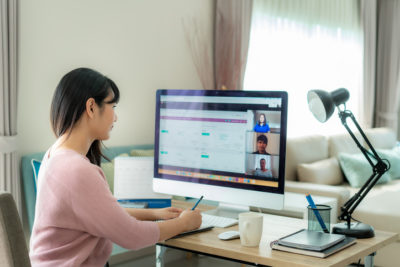
Due to COVID-19, anyone who knows anything about working remotely is sharing their advice. From best communication practices to tips for fending off loneliness, there’s an overwhelming amount of information in circulation and it can be difficult to sort through. Much of this information addresses employee recognition programs, as these can be a great strategy for keeping remote teams connected. But even after narrowing it down to employee recognition program best practices, there’s a lot of information to track. Luckily, we’re here to help.
This article shares a useful checklist for making sure you’re on track with the most essential employee recognition best practices when working remotely. We’ve scoured the many sources available to consolidate everything leaders should keep in mind in one convenient checklist. Some items on the list are specific to the circumstances of COVID-19, and others are timeless truths. Go through the checklist, and make note of which employee recognition program best practices you’re doing great with and which need more attention.
15 Employee Recognition Program Best Practices
1. Employees Know the Program Exists
Maybe your program launch was a little too quiet, or maybe you’re still figuring out how to integrate recognition in your company’s onboarding process. Whatever the case may be, if employees don’t know the program exists, other employee recognition program best practices will hardly make an impact.
2. The Program Is Accessible Across Locations and Devices
Be mindful of time zones and devices when assessing your program’s accessibility. Globally distributed teams will need a program that can be accessed at any time, and employees who don’t do all their work on a computer will be better included if your program includes a mobile recognition app.

3. Rewards Are Meaningful to Employees in Lockdown
Normally, employees would swoon over a rewards catalog brimming with restaurant gift cards, gym memberships, and movie tickets. In the current climate … not so much. In the midst of COVID-19, one key employee recognition program best practice is to revisit your rewards catalog and make sure it includes offers valuable under lockdown. Right now employees especially appreciate meal delivery services, on-demand workout subscriptions, and other gifts and experiences that can be enjoyed from the safety of home.
4. Your Recognition Occasions Are Timely and Relevant
The best employee recognition programs allow administrators to create custom recognition occasions. This helps employees know what to recognize each other for, and also gives leadership some control in encouraging particular behaviors. Like rewards, you should revisit your recognition occasions in light of current events to ensure they still make sense. For example: maybe your company’s leadership normally celebrates taking big risks to drive big results, but has adopted a more conservative mode of operating for the time being. Be sure any recognition occasions aligned with this old initiative are refreshed.

5. You Set Up Recognition Reminders
Like any new habit, it can be challenging to remember to deliver recognition if you’re not used to it. A simple way to increase program participation (and therefore efficacy) is to set up periodic reminders for employees to recognize one another. Monthly or bi-weekly reminders — whether through email, your messaging platform, or a recurring calendar event — can help prompt your team to make recognition a habit without feeling forced.
6. Senior Executives Lead by Example
One of the most important employee recognition program best practices to boost participation is having managers lead by example. If senior executives frequently use your recognition program, it sends the message that it’s important to engage with — and if they don’t, it conveys the opposite

7. You Practice Multi-Directional Recognition
Yes, senior executives play an important role in employee recognition, but employee recognition program best practices call for enthusiastic participants at every level of the organization. In addition to manager-to-peer recognition, you should also enable peer-to-peer, and even peer-to-manager recognition. As long as it’s consistent with the rest of your company culture, keep in mind that multidirectional programs are most engaging.
8. Your Provider Doesn’t Pocket Expired Points
Now more than ever, businesses need to keep a close eye on finances. Many companies unknowingly spend more than they need to on employee recognition programs because they work with vendors that use markups and point expiration to increase profit. Be sure to select a recognition provider with a transparent business model so you’re getting maximum impact without overspending.
9. Recognition Is a Social Experience
When it comes to employee recognition program best practices, making recognition social is a must. Allowing peers to like and comment on their colleague’s accomplishments via a public feed is an easy way to amplify the program’s impact. Recognition passed from one colleague to another is great, but when other peers have the chance to chime in, it means that much more.

10. Employees Can Recognize Privately
For every extroverted employee who relishes the attention that comes with public recognition, there’s an introverted counterpart who would prefer to recognize or be recognized in private. Make sure that’s an option too.
11. You Use Your Program to Incentivize Other Company Initiatives
If you already have a rewards and recognition program, you might as well leverage the platform to distribute incentives for other initiatives. Company wellness challenges and sales SPIFFs are both great examples of ways you can use your employee recognition platform to enable compatible initiatives.

12. You’re Tracking Program Analytics
Perhaps the most critical employee recognition best practice of all is to pay careful attention to program metrics. Analytics can offer insight into participation, employee engagement, management practices, and more.
13. You’re Using the Program to Give Back to Your Community
At a time as difficult as this, everyone needs to be there for each other, and businesses are no exception. If your program includes rewards points that employees can receive and redeem, a timely employee recognition program best practice is to allow employees to use their points to donate to a charity of their choosing.
14. Employees Can Share Feedback About the Program
The best reporters on your program’s efficacy are going to be the people who actually use it. Don’t expect employees to volunteer feedback unsolicited. Rather, make it easy by letting them know exactly who to contact and how if they have thoughts on how the program is performing.

15. You’re Supporting the Employee Experience in Other Ways, Too
The impact of a well-designed employee recognition program is high, but it still shouldn’t be the sole tool your company uses to create a compelling employee experience. Excellent communication, opportunities for professional growth, and plenty of remote employee engagement activities are all musts when managing a remote team.
Show Employees They Matter
Even in times of normalcy, it’s important to be strategic about employee recognition. That said, formal programs are traditionally supplemented by casual instances of in-person recognition, like a high-five from a colleague sitting next to you or a quick “nice job” exchanged walking out of a meeting. But now, with so many teams now completely remote, your formal recognition program is very likely the only form of acknowledgement employees receive. It’s more important than ever that leaders follow employee recognition program best practices to adequately support their teams.
 Katerina Mery is a Marketing Specialist at Fond with a background in cognitive psychology and a passion for improving the way people live and work. She especially enjoys learning about how to accomplish this through rewards and recognition. In her spare time, you can find Katerina running outside, admiring art, and exploring the latest and greatest local restaurants.
Katerina Mery is a Marketing Specialist at Fond with a background in cognitive psychology and a passion for improving the way people live and work. She especially enjoys learning about how to accomplish this through rewards and recognition. In her spare time, you can find Katerina running outside, admiring art, and exploring the latest and greatest local restaurants.
